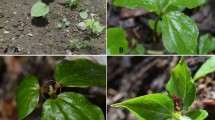Abstract
Angelica glauca is one of the important medicinal plants and it is widely used by indigenous communities for different purposes. The present study analyzes variability in reproductive characters of A. glauca. The reproductive parts were found having significant positive correlation with altitude (e.g., number of umbellets /umber r= 0.857, p<0.05; umbel diameter r=0.735, p<0.05).
Similar content being viewed by others
References
Airi S, Rawal R.S, Dhar U and A.N. Purohit. 1997. Population studies on Podophyllum hexandrum Royle — A dwindling, medicinal plant of the Himalaya. Plant Genetic Resources Newsletter. 110, 29–34.
Anonymous 1985. The Wealth of India: A dictionary of Indian raw materials and industrial products, Vol 1:A. Publication and information Directorate CSIR, New Delhi
Bhatt, A. 2004. Viability and variability in genus Swertia with particular reference to swertia chirayita and Swertia angustifolia in Garhwal and Kumaon Himalaya. Ph.D thesis submitted to H.N.B. Garhwal University, Srinagar Garhwal.
Bisht, A.K. 2002. Conservation and Propagation of a Crically endangered Medicinal Herb, Angelica glauca. Edgew. of western Himalaya. Ph.D thesis submitted to Kumaon University Nainital, Uttaranchal, INDIA.
Chopra, R.N., S.L. Nayar, and I.C. Chopra. 1956. Glossary of Indian medicinal plants. Publication and Information Directorate, CSIR, New Delhi.
Collet, H. 1980. Flora Simlensis, A handbook of the flowering plants of Simla and neighbourhood. Bishen Singh Mahendra Pal Singh, Dehradun.
Gaur, R.D. 1999. Flora of the District Garhwal North-West Himalaya (with ethnobotanical notes). Transmedia, Srinagar (Garhwal), India.
Gupta, S.K., I.A Hamal, and A.K. Koul. 1989. Floral sex ratios in some andromonoecious umbellifers from Kashmir Himalayas. Journal of Plant Science Research 5: 1–7.
Jamwal, M., and B.L. Kaul. 1997. Studies on floral-biology and breeding system of Apium graveolens L. (Celery). Journal of Non Timber Forest Products 4: 73–77.
Joshi, G.C., K.C. Tewari, V. P. Tewari, and N. K. Pande. 2001. Ayurvedic medicinal plants of Uttaranchal. In Samasnt SS, Dhar U and Palni LMS (eds) Himalayan medicinal plants: Potential and prospects, pp 125–150. Gyanodaya Prakashan, Nainital, India
Koul, A.K., P. Koul, and I. Hamal. 1986. A Insects in relation to pollination of some umbellifers. Bulletin. B. S. I. 28: 1–4.
Koul, P., N. Sharma, and A.K. Kaul. 1993. Pollination biology of Apiaceae. Current Science 65: 219–222.
Llyod, D. G., C. J. Webb, and R.B. Primack. 1980. Sexual strategies in plants. II. Data on the temporal regulation of maternal investment. New Phytol 86: 81–92.
Llyod, D.G. 1979a. Parental strategies in angiosperms. Newzealand Journal of Botany 17: 595–606.
Llyod, D.G. 1979b. Some reproductive factors affecting the selection of self-fertilization in plants. American Naturalist 113: 67–79.
Llyod, D.G. 1980. Demographic factors and mating patterns in angiosperms In Solbrig OT (ed) Demography and evolution in plant populations, pp. 677–688. Blackwell, Oxford.
Mac Arthur, R.H., and E.O. Wilson. 1967. The theory of Island. Biogeogrphy, Princeton.
Mishra, C. and Rawat, G.S. 1998. Livestock Grazing and Biodiversity Conservation: Comments on Saberwal. Conservation Biology 12(3): 712–714
Molur, S., and S. Walker. 1998. Report of the workshop “Conservation Assessment and Management Plan for Selected medicinal plants species of northern, northeastern and central India’ (BCCP-Endangered Species Project). Zoo Outreach Organization, Conservation Breeding Specialist Group, Coimbatore, India.
Mukherjee, P.K. 1978. A resume of Indian umbelliferae. Actes du Zeme Symp. Internal. Sur. Les Ombelliferes 47–70.
Petanidou T. N., J.C.M. Den Nifs, and J.G.B Oostermeifer. 1995. Pollination ecology and constraints on seed set of the rare perennial Gentiana ceuciata L. in the Netherlands. Acta Bot Neer., 44: 55–74.
Petit. C. and Thompson, J.D. (1998). Phenotypic selection and population differentiation in relation to habitat heterogeneity in Arrhenatherum elatius. J. Ecol., 86: 829–840.
Puterbaugh, M.N. 1998. The role of ants as flower visitors: experimental analysis in three plant species. Oikos 83: 36–46.
Rawat G.S., and H.S. Rodgers. 1987. Alpine meadows of Uttar Pradesh. An ecological review. Proceedings Natural Rangeland Symposium 119–137.
Samant S.S., U. Dhar, and L.M.S. Palni. 1998. Medicinal plants of Indian Himalaya. Hima Vikas Occassional Publication No-13, GBPIHED, Kosi, ALMORA, India.
Sheldon, J.W., M.J Balick., and S.A. Larida. 1997. Medicinal plants: can utilization and conservation coexist? Advances in Economic Botany 12: 1–104.
Snedechor, G.W., and W.G. Cochran. 1968. Statistical methods. Oxfords and IBH Publishing Co. Pvt. Ltd., New Delhi.
Stephenson AG (1981). Flower and fruit abortion: proximate causes and ultimate functions. Annu. Rev. Ecol. Syst. 12, 253–279.
Wilkinson. 1986. SYSTAT: A system for statistics. Systat-Inc., Evaston II
Willson, M.A., and P.W. Price. 1977. The evaluation of inflorescence sizes in Asclepias (Asclepiadaceae). Evolution 31: 495–511.
Wyatt, R. 1982. Inflorescence architecture: How flower number, arrangement and phenology affect pollination and fruitset. American Journal of Botany 69: 585–594.
Author information
Authors and Affiliations
Corresponding author
Rights and permissions
About this article
Cite this article
Bisht, A.K., Bhatt, A., Rawal, R.S. et al. Assessment of reproductive potential of different populations of Angelica glauca Edgew., a critically endangered Himalayan Medicinal Herb. J. Mt. Sci. 5, 84–90 (2008). https://doi.org/10.1007/s11629-008-0084-1
Received:
Accepted:
Published:
Issue Date:
DOI: https://doi.org/10.1007/s11629-008-0084-1




